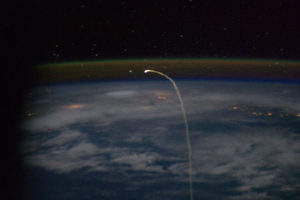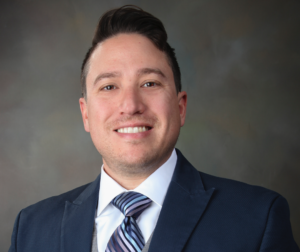Happy returns
Space is making a big comeback. This past year alone, billionaires have launched themselves into orbit, China sent a spacecraft to Mars and NASA’s Mars helicopter traveled the farthest distance yet around the red planet. Nations routinely send thousands of satellites into space for navigation, scientific inquiry and communication. But a lot of what goes up must eventually come down – and that’s where things can go awry.
When objects return to Earth, they may affect other things. A small meteorite, for instance, might hit an airplane. And depending on how it approaches the aircraft and where space rock and machine collide, damage can vary by dramatic degrees. Replace the rock with a satellite or other space debris, and it becomes even more important to understand all the probabilities of what could happen. That’s the focus of Humberto “Tito” Silva III’s work.
Silva, an engineer at Sandia National Laboratories in Albuquerque, New Mexico, models the uncertainty of spacecraft reentry. The research helps technicians better understand how to mitigate safety issues as spacecraft return. This year, the American Institute of Aeronautics and Astronautics – the world’s largest aerospace technical society – named Silva Engineer of the Year.
Silva became interested in aerospace while growing up in western Texas. He devoured books about space. In elementary school, he watched the fatal space shuttle Challenger disaster on television. “It really affected me. I didn’t really understand what death or disaster was at that time.” That vivid memory sealed Silva’s interest in engineering for space applications. He completed his master’s and doctoral degrees in aerospace engineering at Arizona State University before joining Sandia.
Since then, Silva has developed a new way to use supercomputers for uncertainty quantification. UQ, a burgeoning field, uses computer programming and simulations to predict the outcome of different scenarios, including – now – spacecraft reentry.
To test conditions on spacecraft, researchers traditionally obtained a surrogate for the vehicle in question – for instance, an outline of the machine and the material that comprises its skin – and throw it into all sorts of environments. They could place it in an incubator and raise the temperature to study its performance at different temperatures, for instance, or put it through a wind tunnel to see how it does under various conditions. These experiments are sometimes ad hoc and limited to what engineers can manipulate in each environment, Silva explains. “Not even space billionaires have the time and money to study every single possible scenario. Without being able to design an experiment that encapsulates all the possible scenarios that might be of interest, you’re just working with a black box.” Meanwhile, he adds, that testing surrogate pieces in different environments can be cumbersome and may produce nothing of value.
In 2012, limited hardware and computing resources got Silva thinking about devising a model that uses parametric perturbations, machine learning and other techniques for studying uncertainty. Available experimental parameters and data would be fed into the model, along with any reported uncertainties. The model would then iterate through that probability space. Silva’s goal is to use what he calls his “full-circle analysis methodology” to determine the fewest number of computer simulations needed “to help us design another experiment that gets us more information than before.”
The methodology has been successful in helping Silva solve research questions that were previously deemed intractable. For starters, it narrows down the number of experiments: What would have been 5 million computer simulations could yield 5,000-some experiments. Or, if engineers start with 5,000 possible experiments, the method helps narrow them to 50, he explains. “That’s many orders of magnitude of saved time and money.”
Silva and colleagues have run tens of thousands of simulations over many years on multiple Sandia systems. His team also collaborates with Los Alamos National Laboratory, using his computer models to study reentry vehicles in different thermal settings.
And since the award was announced, earth scientists, theoretical physicists and others have contacted Silva to see how his method can be applied to their research questions – from extreme states in the Arctic and to black holes.
For Silva, the exciting part of his work isn’t just using this method to study spacecraft but applying it across fields to reduce the amount of resources other scientists need to answer questions.
“We’ve figured out a way, by using logic and the different technologies, to minimize the number of simulations you have to run – either computationally or experimentally. There’s a lot more computing resources now than five to 10 years ago, and so we want to take this method and utilize it across a variety of different fields.”
Silva sees room to improve his methods, too. “All models have limitations, so we try and make our models more and more useful. We’re never at a space that we’re happy with. We’re always trying to improve the fidelity of our models.”
About the Author
Wudan Yan is a Seattle-based freelance science writer.






